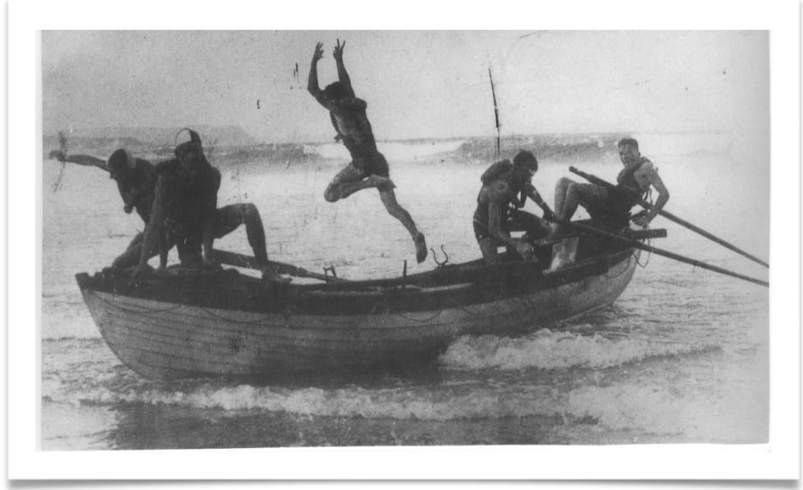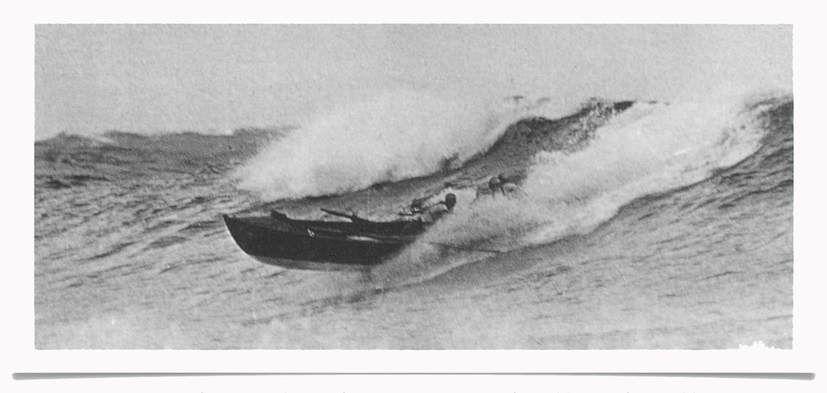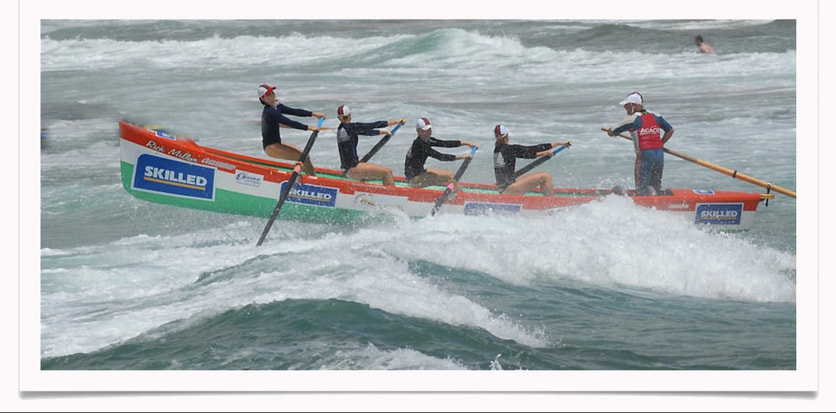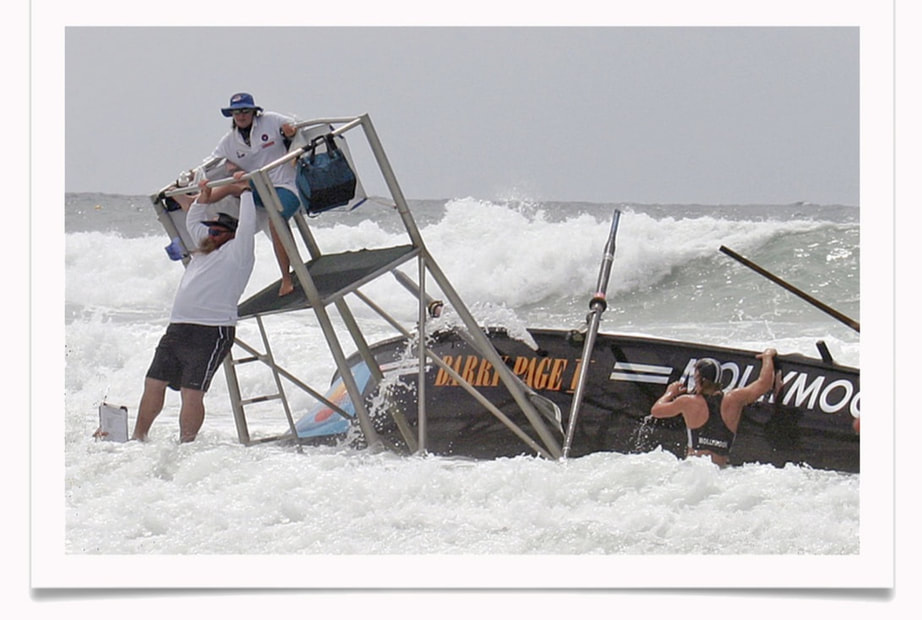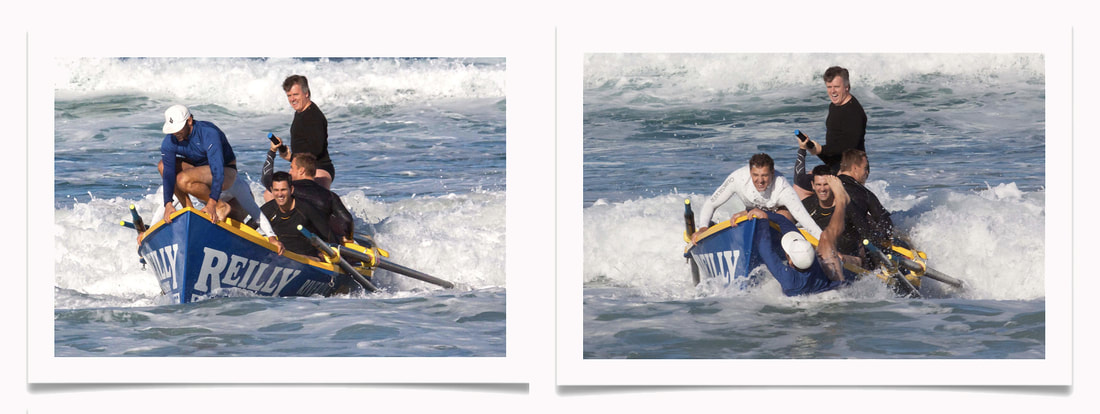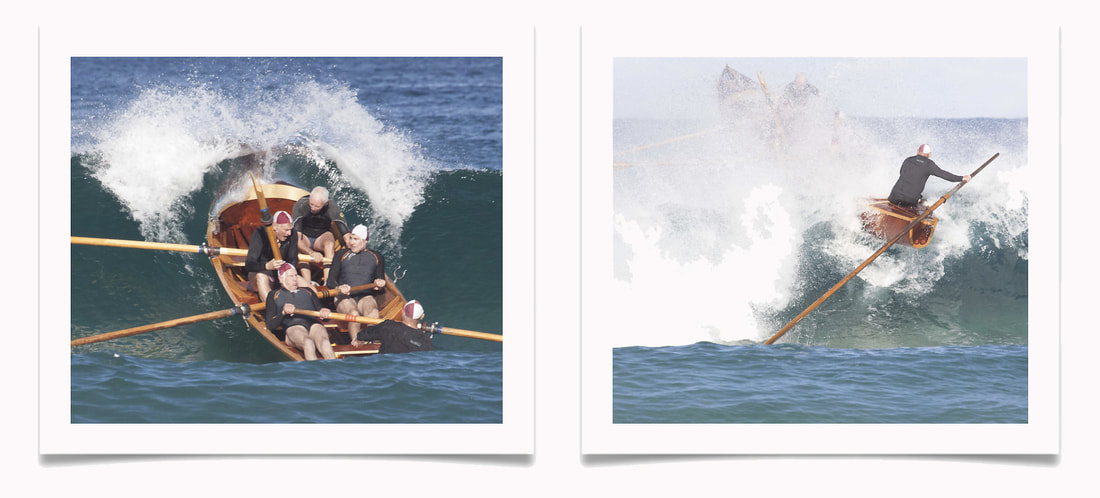SURFBOAT CULTURE
TRADITION
Surfboats traditionally evolved within the surf life saving movement. Originally this was a natural fit as surfboats developed through the 1920s and into the 1970s as an effective surf rescue craft saving many lives. Boards and surf skis were also used as rescue craft. Beltmen swam through the surf dragging a line behind them to reach stricken swimmers. The line was attached to a reel manned by linesmen on the beach. This could be dangerous if the line was fouled on rocks or weighed down with seaweed. Sometimes beltmen and their patients were nearly drowned when dragged under water by over enthusiastic linesmen pulling them in too fast! Similarly a line and belt were fitted in the bow of surfboats to enable a beltman to swim a line from the boat to swimmers. At times the line was swum to the beach to recover the surfboat when it was swamped.
As well as being a rescue craft surfboats commenced racing in spectacular fashion at early surf carnivals. The first race with purpose built surfboats was held at Freshwater Beach in 1915. It was won by Freshwater swept by Dick Matheson. The feats of some of the crews seemed larger than life with a combination of gallantry and villainy that continues to the modern day.
The surfboat has been superceded as a recue craft by the development of new equipment and procedures. It is interesting how quickly we consider past effective methods to be antiquated and irrelevant. The truth is surfboats successfully saved thousands of lives in an era when the crowds on popular beaches were far greater than they are today.
Advances in surf rescue and first aid procedures over the last 50 years have revolutionised surf life saving. Large jet rescue boats were introduced in small numbers through the 1960s. Inflatable rescue boats (IRBs) were developed through the 1970s. Now jet ski rescue craft have been adapted to surf rescue with great results. Even helicopters are available as back up in many areas. Rescue drones are currently being developed. Consequently, traditional surfboats have been sidelined as a rescue craft and are now only used for racing. Consequently specification changes have reflected the desire to increase the speed of the surfboat in open water.
As well as being a rescue craft surfboats commenced racing in spectacular fashion at early surf carnivals. The first race with purpose built surfboats was held at Freshwater Beach in 1915. It was won by Freshwater swept by Dick Matheson. The feats of some of the crews seemed larger than life with a combination of gallantry and villainy that continues to the modern day.
The surfboat has been superceded as a recue craft by the development of new equipment and procedures. It is interesting how quickly we consider past effective methods to be antiquated and irrelevant. The truth is surfboats successfully saved thousands of lives in an era when the crowds on popular beaches were far greater than they are today.
Advances in surf rescue and first aid procedures over the last 50 years have revolutionised surf life saving. Large jet rescue boats were introduced in small numbers through the 1960s. Inflatable rescue boats (IRBs) were developed through the 1970s. Now jet ski rescue craft have been adapted to surf rescue with great results. Even helicopters are available as back up in many areas. Rescue drones are currently being developed. Consequently, traditional surfboats have been sidelined as a rescue craft and are now only used for racing. Consequently specification changes have reflected the desire to increase the speed of the surfboat in open water.
SURFBOATS TODAY
Boaties were a fiercely independent group of surf life savers known for their toughness and bravado often running counter to officialdom. Today surfboats are a bit of a mixing pot of past DNA with growing influences from stillwater rowing. Added to this surfboats are governed by the SLSA, a body which is a conglomeration of a volunteer based community service and a range of surf sport disciplines spanning swimming, athletics, kayaking and rowing. The SLSA is a not for profit organisation based on volunteering. Its bureaucracy is divided into national, state, branch and local club organisations. Surf life saving is administered at its many levels by dedicated voluntary office bearers and paid managerial staff. Financially it relies on government funding, sponsorships and branding partnerships. Attempts to blend such an organisation with such a wide range of interests and modes of operation do not always satisfy all parties. Recent administrative changes to separate surf sports have had mixed results depending on the professional (paid) staffs’ appreciation of the particular surf sport and the passion of its enthusiasts.
The sport of surfboats is at a critical point in danger of becoming a bland over regulated activity only practised in calm conditions. If the surfing element becomes too diminished a void may occur diverting some enthusiasts to non surf coastal rowing which is becoming popular in Europe as a form of open sea marathon rowing.
The SLSA (Surf Life Saving Association) sometimes appears to take surfboats for granted. They need to sympathetically manage surfboats through this current era of safety concerns and avoid reactionary decisions that lack experienced guidance. There has been no apparent initiative to improve safety through improving surf skills.
Surfboat competitors train extremely hard for an amateur sport. Many outside the sport are surprised by the intensity and number of training sessions competitive crews undergo each week. Sessions include boatwork on flat water and in the surf as well as fitness and weight training. Out of boat fitness can include circuit training, ergometers (rowing machines), running and cycling. Most surfboat competitors focus on nutrition.
The amount of competition events and related travel can be very demanding. Yet surf conditions can influence performance and competitive results.
Surfboat competitors must belong to a surf life saving club and participate in voluntary beach patrols .
The sport of surfboats is at a critical point in danger of becoming a bland over regulated activity only practised in calm conditions. If the surfing element becomes too diminished a void may occur diverting some enthusiasts to non surf coastal rowing which is becoming popular in Europe as a form of open sea marathon rowing.
The SLSA (Surf Life Saving Association) sometimes appears to take surfboats for granted. They need to sympathetically manage surfboats through this current era of safety concerns and avoid reactionary decisions that lack experienced guidance. There has been no apparent initiative to improve safety through improving surf skills.
Surfboat competitors train extremely hard for an amateur sport. Many outside the sport are surprised by the intensity and number of training sessions competitive crews undergo each week. Sessions include boatwork on flat water and in the surf as well as fitness and weight training. Out of boat fitness can include circuit training, ergometers (rowing machines), running and cycling. Most surfboat competitors focus on nutrition.
The amount of competition events and related travel can be very demanding. Yet surf conditions can influence performance and competitive results.
Surfboat competitors must belong to a surf life saving club and participate in voluntary beach patrols .
ASRL – AUSTRALIAN SURF ROWERS LEAGUE
The ASRL has evolved as a body that represents the interests of surfboat competitors. No other surf sport under the SLSA umbrella has ever had similar representation.
The existence and survival of a level headed independent body such as the ASRL is important to help guide the future of surfboats. The Navy sponsorship of the ASRL has been very helpful to our sport. On a lighter note the sight of dozens of surfboats with Navy signage must impress foreign tourists and create a healthy respect for our defence capabilities!
The existence and survival of a level headed independent body such as the ASRL is important to help guide the future of surfboats. The Navy sponsorship of the ASRL has been very helpful to our sport. On a lighter note the sight of dozens of surfboats with Navy signage must impress foreign tourists and create a healthy respect for our defence capabilities!
SURFBOAT OFFICIALS
Boaties have a strange relationship with surfboat officials – we love ‘em and we hate ‘em. More ex surfboat competitors need to become officials. Few boaties realise how tough it is being in the water on a stand for hours judging surfboat race finishes. Sometimes they are buffeted by waves while trying to concentrate on a tangle of boats as they cross the line.
Judging a tight finish is a tough task. At times the Judges on one side of the finish line disagree with those at the other end.
In the 1980s two boats crossed the line together in the Australian Open Surfboat Final. The two judging stands picked a different winner – then after over 20 minutes of discussion, miraculously one boat was awarded the win and the other a disgruntled second place!
One of the rules of nature is that most surfboat competitors think Starters are hopeless. Unfortunately too few are game enough to have a go at it themselves.
Abusing Starters is a colourful pastime that fails to take into account it is the Sweeps responsibility to decide when the crew should enter the boat. The Starter simply indicates when the crews can commence boarding! The rules state a start cannot be protested which makes complaining fruitless – but it can make you feel better!
Officials are the backbone of our sport. Most perform their duties to support the surfboat movement and its participants. As with all sports there can be a few that seem to be motivated by some sort of power trip. There have been some legendary characters good and bad that are ingrained into surfboat folklore.
Selection and promotion of officials is probably based on an official assessment system. Perhaps there should be more feedback sought and given by experienced competitors.
Judging a tight finish is a tough task. At times the Judges on one side of the finish line disagree with those at the other end.
In the 1980s two boats crossed the line together in the Australian Open Surfboat Final. The two judging stands picked a different winner – then after over 20 minutes of discussion, miraculously one boat was awarded the win and the other a disgruntled second place!
One of the rules of nature is that most surfboat competitors think Starters are hopeless. Unfortunately too few are game enough to have a go at it themselves.
Abusing Starters is a colourful pastime that fails to take into account it is the Sweeps responsibility to decide when the crew should enter the boat. The Starter simply indicates when the crews can commence boarding! The rules state a start cannot be protested which makes complaining fruitless – but it can make you feel better!
Officials are the backbone of our sport. Most perform their duties to support the surfboat movement and its participants. As with all sports there can be a few that seem to be motivated by some sort of power trip. There have been some legendary characters good and bad that are ingrained into surfboat folklore.
Selection and promotion of officials is probably based on an official assessment system. Perhaps there should be more feedback sought and given by experienced competitors.
SURFBOAT MATESHIP
The healthy coastal lifestyle of surfboats has fostered long standing friendships throughout the surfboat world. In some areas there is a sense that the surfboat scene is almost a separate community.
The SLSA does not appear to fully appreciate the strong bond that exists within the surfboat niche of their membership.
Like true friends, crewmates sometimes seem happiest when a mate experiences misfortune! This was highlighted when a Bungan crew reunited at the ashes scattering of an old friend. Known for their remarkable past boatmanship the reunited crew could not resist revisiting memory lane with some bow riding.
Please note riding the bow is not recommended or endorsed by this website! But it can be fun! In the past, experienced boaties sometimes rode the oar blades as they trailed beside the boat on sizable rolling waves. In the current era of ticking boxes and allocating liabilities such enjoyable challenges will probably only exist in memory lane. Surfboats can be much more than just a competition based sport.
The SLSA does not appear to fully appreciate the strong bond that exists within the surfboat niche of their membership.
Like true friends, crewmates sometimes seem happiest when a mate experiences misfortune! This was highlighted when a Bungan crew reunited at the ashes scattering of an old friend. Known for their remarkable past boatmanship the reunited crew could not resist revisiting memory lane with some bow riding.
Please note riding the bow is not recommended or endorsed by this website! But it can be fun! In the past, experienced boaties sometimes rode the oar blades as they trailed beside the boat on sizable rolling waves. In the current era of ticking boxes and allocating liabilities such enjoyable challenges will probably only exist in memory lane. Surfboats can be much more than just a competition based sport.
FAREWELLING A CREW MEMBER
The depth of the surfboat family can be seen when old friends respectfully scatter a crewmates ashes upon the sea.
Typical of many crews, the 1970s Freshwater Open Surfboat crew of Ron Payne, Ken Bucknall, Kim Marsh, Christopher Branson and Les Watt developed lifetime friendships. On May 19, 2013 the crew scattered Chris’s ashes off Freshwater Beach following a memorial service to celebrate his remarkable life. They rowed a restored 1971 Clymer surfboat with Col Scully, a mate of Chris’s from his Warriewood crew, rowing on Chris’s seat. On the way to sea Scully’s second bow oar mysteriously broke.
Typical of many crews, the 1970s Freshwater Open Surfboat crew of Ron Payne, Ken Bucknall, Kim Marsh, Christopher Branson and Les Watt developed lifetime friendships. On May 19, 2013 the crew scattered Chris’s ashes off Freshwater Beach following a memorial service to celebrate his remarkable life. They rowed a restored 1971 Clymer surfboat with Col Scully, a mate of Chris’s from his Warriewood crew, rowing on Chris’s seat. On the way to sea Scully’s second bow oar mysteriously broke.
